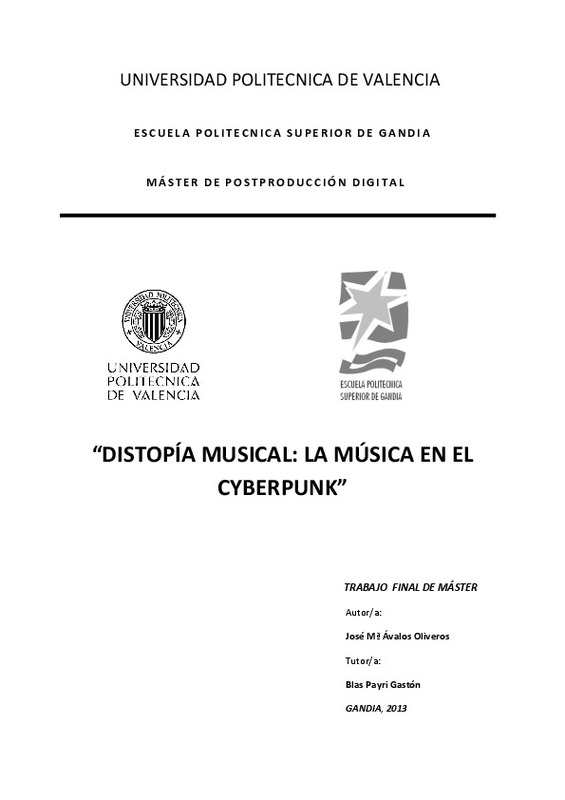JavaScript is disabled for your browser. Some features of this site may not work without it.
Buscar en RiuNet
Listar
Mi cuenta
Estadísticas
Ayuda RiuNet
Admin. UPV
Distopía musical: La música en el cyberpunk
Mostrar el registro sencillo del ítem
Ficheros en el ítem
| dc.contributor.advisor | Payri Lambert, Blas Gastón
|
es_ES |
| dc.contributor.author | Ávalos Oliveros, José María
|
es_ES |
| dc.date.accessioned | 2014-01-29T09:14:50Z | |
| dc.date.available | 2014-01-29T09:14:50Z | |
| dc.date.created | 2013-09-03 | |
| dc.date.issued | 2014-01-29 | |
| dc.identifier.uri | http://hdl.handle.net/10251/35224 | |
| dc.description.abstract | El presente estudio tiene como objetivo fundamental conocer los distintos tipos de música que se han aplicado en el sub-género conocido como Cyberpunk, en la industria cinematográfica durante las últimas tres décadas. A través de un total de doce películas pertenecientes al sub-género del Cyberpunk, hemos podido estudiar el trabajo de once compositores de música para cine, habiendo realizado un análisis de todos ellos. Los compositores trabajan de diversas formas: mediante orquesta sinfónica, mediante sintetizadores, o bien haciendo una mezcla de ambos estilos de creación sonora. Los films escogidos para investigar la música Cyberpunk, así como sus respectivos compositores, son los siguientes: Blade Runner (1982); Tron (1982); The Terminator (1984); Brazil (1985); Robocop (1987); Total Recall (1990); Terminator 2: Judgment Day (1991); The Matrix (1999); Minority Report (2002); Tron Legacy (2010); Total Recall (2012); Looper (2012). La conclusión primordial de este estudio es que ningún compositor se amolda a unas reglas concretas para escribir música Cyberpunk. No hay un estilo preestablecido ni unas pautas a seguir. Cada músico aporta una novedad distinta, por lo general, en cada uno de los films citados anteriormente. También hay que tener en cuenta factores como la época en la que se compone la música, las canciones (en caso de que haya) que se utilizan en la banda sonora junto al Score escrito por el músico, teniendo normalmente un carácter comercial y la influencia que puede tener sobre otras producciones del género. | es_ES |
| dc.description.abstract | This study's main purpose is to know the different types of music that have been applied in the sub-genre known as Cyberpunk, in the film business over the last three decades. Through a total of twelve films from the sub-genre of Cyberpunk we were able to study the work of eleven composers of film music, having performed an analysis for all of them. The composers working in various ways: by symphony orchestra, using synthesizers or by a mixture of both styles for the sound creation. The films selected to investigate Cyberpunk music, as well as their respective composers are: Blade Runner (1982); Tron (1982); The Terminator (1984); Brazil (1985); Robocop (1987); Total Recall (1990); Terminator 2: Judgment Day (1991); The Matrix (1999); Minority Report (2002); Tron Legacy (2010); Total Recall (2012), music by Harry Gregson-Williams; Looper (2012). The primary conclusion of this study is that no composer conforms to specific rules to write Cyberpunk music. There is no a preset style or some guidelines to follow. In general, each musician brings a new distinct in each of the aforementioned films. We must also take into account factors such as the time in which the music is composed, songs (in case there is) used on the soundtrack joint the Score written by a musician, having a commercial intent and the influence it may have on other productions of the same genre. | es_ES |
| dc.format.extent | 51 | es_ES |
| dc.language | Español | es_ES |
| dc.publisher | Universitat Politècnica de València | es_ES |
| dc.rights | Reserva de todos los derechos | es_ES |
| dc.subject | Cyberpunk | es_ES |
| dc.subject | Banda sonora | es_ES |
| dc.subject | Partitura | es_ES |
| dc.subject | Compositor | es_ES |
| dc.subject | Color | es_ES |
| dc.subject | Soundtrack | es_ES |
| dc.subject | Score | es_ES |
| dc.subject | Composer | es_ES |
| dc.subject.classification | COMUNICACION AUDIOVISUAL Y PUBLICIDAD | es_ES |
| dc.subject.other | Máster Universitario en Postproducción Digital-Màster Universitari en Postproducció Digital | es_ES |
| dc.title | Distopía musical: La música en el cyberpunk | es_ES |
| dc.type | Tesis de máster | es_ES |
| dc.rights.accessRights | Abierto | es_ES |
| dc.contributor.affiliation | Universitat Politècnica de València. Escuela Politécnica Superior de Gandia - Escola Politècnica Superior de Gandia | es_ES |
| dc.contributor.affiliation | Universitat Politècnica de València. Departamento de Comunicación Audiovisual, Documentación e Historia del Arte - Departament de Comunicació Audiovisual, Documentació i Història de l'Art | es_ES |
| dc.description.bibliographicCitation | Ávalos Oliveros, JM. (2013). Distopía musical: La música en el cyberpunk. Universitat Politècnica de València. http://hdl.handle.net/10251/35224 | es_ES |
| dc.description.accrualMethod | Archivo delegado | es_ES |
Este ítem aparece en la(s) siguiente(s) colección(ones)
-
EPSG - Trabajos académicos [5004]
Escuela Politécnica Superior de Gandia





![MS Word file [Word]](/themes/UPV/images/msword.png)

